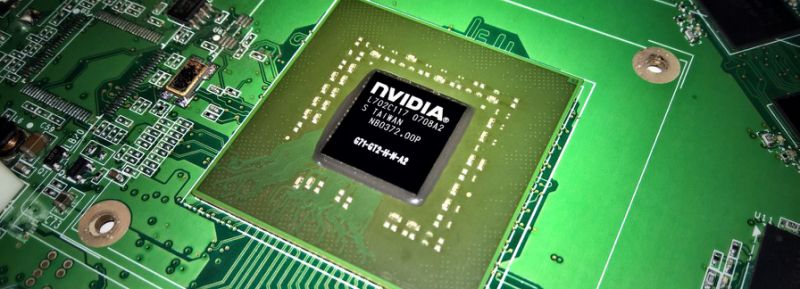
Anyone who held for that rewarding ride would probably be keen to talk about it.
<p class="canvas-atom canvas-text Mb(1.0em) Mb(0)–sm Mt(0.8em)–sm" type="text" content=" See our latest analysis for NVIDIA ” data-reactid=”20″>See our latest analysis for NVIDIA
To quote Buffett, ‘Ships will sail around the world but the Flat Earth Society will flourish. There will continue to be wide discrepancies between price and value in the marketplace…’ One way to examine how market sentiment has changed over time is to look at the interaction between a company’s share price and its earnings per share (EPS).
During five years of share price growth, NVIDIA achieved compound earnings per share (EPS) growth of 31% per year. This EPS growth is slower than the share price growth of 62% per year, over the same period. So it’s fair to assume the market has a higher opinion of the business than it did five years ago. And that’s hardly shocking given the track record of growth. This optimism is visible in its fairly high P/E ratio of 57.95.
The company’s earnings per share (over time) is depicted in the image below (click to see the exact numbers).

<p class="canvas-atom canvas-text Mb(1.0em) Mb(0)–sm Mt(0.8em)–sm" type="text" content="Dive deeper into NVIDIA's key metrics by checking this interactive graph of NVIDIA's earnings, revenue and cash flow.” data-reactid=”36″>Dive deeper into NVIDIA’s key metrics by checking this interactive graph of NVIDIA’s earnings, revenue and cash flow.
What About Dividends?
<p class="canvas-atom canvas-text Mb(1.0em) Mb(0)–sm Mt(0.8em)–sm" type="text" content="When looking at investment returns, it is important to consider the difference between total shareholder return (TSR) and share price return. Whereas the share price return only reflects the change in the share price, the TSR includes the value of dividends (assuming they were reinvested) and the benefit of any discounted capital raising or spin-off. So for companies that pay a generous dividend, the TSR is often a lot higher than the share price return. In the case of NVIDIA, it has a TSR of 1057% for the last 5 years. That exceeds its share price return that we previously mentioned. This is largely a result of its dividend payments!” data-reactid=”38″>When looking at investment returns, it is important to consider the difference between total shareholder return (TSR) and share price return. Whereas the share price return only reflects the change in the share price, the TSR includes the value of dividends (assuming they were reinvested) and the benefit of any discounted capital raising or spin-off. So for companies that pay a generous dividend, the TSR is often a lot higher than the share price return. In the case of NVIDIA, it has a TSR of 1057% for the last 5 years. That exceeds its share price return that we previously mentioned. This is largely a result of its dividend payments!
A Different Perspective
<p class="canvas-atom canvas-text Mb(1.0em) Mb(0)–sm Mt(0.8em)–sm" type="text" content="It's nice to see that NVIDIA shareholders have received a total shareholder return of 66% over the last year. Of course, that includes the dividend. That's better than the annualised return of 63% over half a decade, implying that the company is doing better recently. In the best case scenario, this may hint at some real business momentum, implying that now could be a great time to delve deeper. If you would like to research NVIDIA in more detail then you might want to take a look at whether insiders have been buying or selling shares in the company.” data-reactid=”40″>It’s nice to see that NVIDIA shareholders have received a total shareholder return of 66% over the last year. Of course, that includes the dividend. That’s better than the annualised return of 63% over half a decade, implying that the company is doing better recently. In the best case scenario, this may hint at some real business momentum, implying that now could be a great time to delve deeper. If you would like to research NVIDIA in more detail then you might want to take a look at whether insiders have been buying or selling shares in the company.
<p class="canvas-atom canvas-text Mb(1.0em) Mb(0)–sm Mt(0.8em)–sm" type="text" content="If you are like me, then you will not want to miss this free list of growing companies that insiders are buying.” data-reactid=”41″>If you are like me, then you will not want to miss this free list of growing companies that insiders are buying.
<p class="canvas-atom canvas-text Mb(1.0em) Mb(0)–sm Mt(0.8em)–sm" type="text" content="Please note, the market returns quoted in this article reflect the market weighted average returns of stocks that currently trade on US exchanges.” data-reactid=”42″>Please note, the market returns quoted in this article reflect the market weighted average returns of stocks that currently trade on US exchanges.
<p class="canvas-atom canvas-text Mb(1.0em) Mb(0)–sm Mt(0.8em)–sm" type="text" content="If you spot an error that warrants correction, please contact the editor at [email protected]. This article by Simply Wall St is general in nature. It does not constitute a recommendation to buy or sell any stock, and does not take account of your objectives, or your financial situation. Simply Wall St has no position in the stocks mentioned.
We aim to bring you long-term focused research analysis driven by fundamental data. Note that our analysis may not factor in the latest price-sensitive company announcements or qualitative material. Thank you for reading.” data-reactid=”43″>If you spot an error that warrants correction, please contact the editor at [email protected]. This article by Simply Wall St is general in nature. It does not constitute a recommendation to buy or sell any stock, and does not take account of your objectives, or your financial situation. Simply Wall St has no position in the stocks mentioned.
We aim to bring you long-term focused research analysis driven by fundamental data. Note that our analysis may not factor in the latest price-sensitive company announcements or qualitative material. Thank you for reading.










